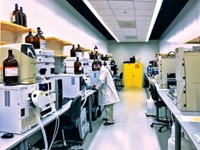Advertisement
Grab your lab coat. Let's get started
Welcome!
Welcome!
Create an account below to get 6 C&EN articles per month, receive newsletters and more - all free.
It seems this is your first time logging in online. Please enter the following information to continue.
As an ACS member you automatically get access to this site. All we need is few more details to create your reading experience.
Not you? Sign in with a different account.
Not you? Sign in with a different account.
ERROR 1
ERROR 1
ERROR 2
ERROR 2
ERROR 2
ERROR 2
ERROR 2
Password and Confirm password must match.
If you have an ACS member number, please enter it here so we can link this account to your membership. (optional)
ERROR 2
ACS values your privacy. By submitting your information, you are gaining access to C&EN and subscribing to our weekly newsletter. We use the information you provide to make your reading experience better, and we will never sell your data to third party members.
Business
Drug Developers Align In The U.K.
Universities, industry, and charities reposition to enhance their chances of collaborating in the biomedical sciences
by Alex Scott
September 29, 2014
| A version of this story appeared in
Volume 92, Issue 39

In what is set to be an unprecedented move for the U.K. biotechnology sector, six not-for-profit organizations will meld their biomedical research teams together next year to create the Francis Crick Institute, a center in the middle of London focused on drug discovery and early-stage drug development.
The center will house 1,200 scientists—including chemists, biologists, physicists, and clinicians—from the U.K. government’s Medical Research Council; the charities Cancer Research UK and the Wellcome Trust; and University College London, Imperial College London, and King’s College London. It is set to be one of the biggest biomedical research centers in all of Europe.
The soon-to-be-opened complex, nicknamed the Crick, is symbolic of a broader alignment of universities, charities, and drug companies involved in biomedical research across the U.K., experts say. Such organizations have worked together in the country for years, but recently they have increased emphasis on sharing tools, data, computer systems, and even workplaces to accelerate progress.
The Crick seeks to emulate the large-scale research collaborations of the U.S. But some critics say this model could create problems in the U.K. by diverting what is a relatively small pool of academics from their traditional roles as teachers and developers of blue-sky science. Others are concerned that charities and universities may lose the benefits of the intellectual property (IP) generated by those biomedical researchers.
Senior scientists involved in the research are determined such issues won’t hold them back. “We want to take open science collaboration in Europe to another level,” says David Roblin, the Crick’s chief operating officer and former head of research at Pfizer’s now-shrunken R&D center in Sandwich, England.
Roblin unabashedly proclaims that a key part of the Crick’s strategy is to embrace drug companies. He hopes to attract several big pharma firms and embed an entrepreneur from these companies in every early-stage drug development team. “We need a nursery of ideas,” he says.
Big pharma is receptive to the idea, says Roblin, who doesn’t anticipate IP-related conflicts. In exchange for big pharma’s involvement, the Crick is prepared to offer companies some control over IP. If big pharma makes “a reasonable offer” for IP from a given project, then the Crick, which is a not-for-profit organization seeking to get drug therapies to the clinic as fast as possible, will be willing to accept it and press ahead, Roblin says.
The Crick is set to incorporate approaches already used in major research facilities in the U.S., where Sir Paul Nurse, the Crick’s director, was president of Rockefeller University from 2003 to 2011. “He will be thinking very deeply about what works and how to take it to the next level,” Roblin says.
Some deep thinking on how to enhance collaboration has also been taking place at AstraZeneca. A declining drug development pipeline prompted its senior executives to relocate the firm’s R&D headquarters from an isolated location in the north of England to a science campus adjacent to the University of Cambridge in the heart of what is already the U.K.’s biggest biotech hub. The firm’s new R&D facilities are due to open in Cambridge in late 2016.
AstraZeneca is already working hard behind the scenes to ensure that it is effectively reaching out to biotech partners, including those in academia, says David Andrews, head of AstraZeneca’s oncology lead generation chemistry group. He and other biomedical researchers spoke recently at the Tetrahedron Symposium in London, which focused on the academia-industry interface.
“AstraZeneca has stepped up its emphasis on partnerships in the past three years or so,” Andrews says. One focus of its activities has been swapping collections of compounds with organizations such as the Medical Research Council. The owner of the compounds makes them free for other partners to use. “It’s clean, and there are no strings attached,” Andrews says. AstraZeneca “wasn’t the earliest mover” in open innovation projects, he acknowledges, “but we’re working with more academic routes as time goes on.”
London, about an hour’s drive south of AstraZeneca’s planned research quarters in Cambridge, has already proved to be a happy biomedical hunting ground for Johnson & Johnson. The firm opened an innovation center in the capital last year and since then has struck several deals in a range of therapy areas. The deals are partly a result of moving close to prospective partners, according to Declan Jones, head of neuroscience for J&J. “We didn’t expect proximity to innovators in London to have such a major impact,” he says.
J&J is using a number of collaborative approaches. For example, it plans to open a virtual incubator space for projects with prospective partners in the U.K. And it is already deeply involved in multipartner projects such as the Dementia Consortium, which it started in January with Eisai, Eli Lilly & Co., and Alzheimer’s Research UK, a charitable organization.
The partners in the consortium, which is focused on therapies for Alzheimer’s disease, are working together to identify novel drug targets. “Once a target is found, the companies can go and do drug development all the way to market. It’s a very good example of the way the world is going,” Jones says.
In the absence of big pharma partners such as J&J, the Wellcome Trust is a potential bridge to industry for early-stage drug developers from academia. The London-based organization has an endowment that provides it with an annual budget of $140 million to distribute “proper funding between the academic-industry interface,” says Keith Spencer, business development analyst for the Wellcome Trust. Typically it provides projects with about $1.6 million per year for one to two years.
The organization has 60 active projects and takes on between three and six annually. “We don’t treat it as a grant—it’s product development,” Spencer says. But the goal is always cures, not returns. “We’re not trying to maximize return on investment,” he adds.

The Wellcome Trust wants to participate in areas with funding gaps. This can mean helping academics develop a compound to make it appealing to commercial partners. But the organization also has broader interests. “We help spin-out companies and industry, too,” Spencer says. For example, over the past two years the Wellcome Trust “realized small-molecule drug discovery funding was poor,” he adds. So the organization began funding early-stage activities, such as screening development and lead optimization.
Meanwhile, the Institute of Cancer Research (ICR), a London-based nonprofit, has shown that a charitable organization can also become a successful drug developer. The academic institute has developed 17 drug candidates since 2005. One of them, a commercial prostate cancer therapy called abiraterone, might become a billion-dollar drug, says Chief Executive Paul Workman.
ICR developed abiraterone to the clinical trial phase and then partnered with J&J to take it to market as Zytiga. Largely through fund-raising, the institute had an income of $17 million in 2013. That figure is set to rise to $43 million in 2014, mainly because of a significant financial contribution from its new cancer drug, which won U.S. approval in late 2012.
“The story is an exemplar of how basic molecular studies, followed by collaborations between researchers, doctors, and industry, can lead to the successful development of effective drugs that can transform lives,” ICR says on its website.
But if partnerships are to work, all parties must agree on how to handle IP, Workman observes. “I think you can put things into the public domain, publish a lot of information, and still hold on to the intellectual property. It’s not easy, but it can be done,” he says.
Fruitful collaboration between academia and industry depends on acknowledging the two camps’ different views on IP, according to David G. Brown, a professor of structural biology at the University of Kent.
“As long as academics aren’t greedy when it comes to IP, then it will be a successful model,” he says. “That’s probably a major hurdle going forward. It’s about realizing where IP does lie and who is risking what,” says Brown, who has an unusual perspective because he has a second role running a small team of chemists who provide structure-based drug discovery services for Charles River Laboratories, a contract research organization.
Changes are required, though, if biomedical collaborations in the U.K. are really to push on to the next level. “We need to embrace that academia-industry interface and make it easier to access,” Brown says. “To do the biology to ensure that you have the right target, this is where you will see much more collaborative activity. The universities just don’t have the money to take things forward at the later stage, but where we do have ability is in the early stages.”
The push to collaborate, however, bumps up against pressure on U.K. universities to stick to their primary roles of carrying out research and teaching. “Much of the infrastructure for drug discovery already exists in major universities,” says Chris Abell, a biological chemistry professor at the University of Cambridge and a serial biotech entrepreneur. But it’s there to help carry out fundamental science rather than drug discovery, he adds.
Abell asserts that universities’ best contribution is target validation and recruitment of patients into trials rather than participation in the discovery of drugs themselves. And universities should use their skills in areas ignored by big pharma but that are in need of therapies, such as drug-resistant tuberculosis. AstraZeneca pulled out of early-stage R&D for this field, “which is a real tragedy,” he says.
Abell is determined that universities shouldn’t become outsourcing partners for big pharma. “I say to industry, ‘Please don’t see academia as a gateway for public funds.’ ”
But with big pharma’s blockbuster drugs model seemingly busted, industry’s interest in working with academia and not-for-profit organizations continues to rise. “An academic bridge has never been so important or more the subject of focus than now,” says Kevin Bottomley, managing director of London-based Results Healthcare, an adviser to the health care sector. Bottomley cautions big pharma managers against trying to dictate what universities are doing by micromanaging projects. This could drive out the creativity that they are craving from academia in the first place, he says.
“Another reason for big pharma not imposing their systems on universities is that the organizations that are good at developing drugs are not necessarily the ones that are good at identifying novel drug targets and therapeutic modalities,” Bottomley warns.
It remains to be seen whether the U.K.’s research institutes and drug companies can avoid such pitfalls and truly align their activities as they step up the intensity of their collaborations. “It’s an experiment,” says the Crick’s Roblin, referring to his institute’s own plans to build Europe’s most collaborative biomedical center. If the no-walls approach at the Crick gets results in the clinic, though, expect to see more large-scale biomedical collaborations cropping up across the U.K.





Join the conversation
Contact the reporter
Submit a Letter to the Editor for publication
Engage with us on Twitter